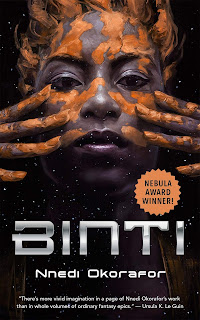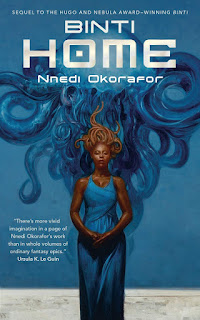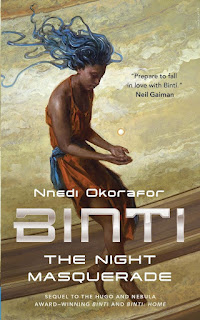 |
| Book cover |
There is a lot to unpack in the world-building and the world is built along with the story. Each chapter is unusually episodic, in that some small part of the last scene of a previous chapter will be often be repeated at the beginning of the next. This took a little getting used to, but I imagine is much easier for readers who are going to read one chapter, and put the book down for a day or two.
Like much of my my favorite Sci-Fi, this book explores racial tensions and cultural wounds through the lens of the far off and vastly different. The character Binti's understanding of mathematics and electronics is described as magical, as if some humans evolved to be able to create and control electrical currents in their mind. It does a great service to explaining how distant future culture and humans have become from what we are used to now.
This is a great story, but is very brief, and suspect the book may have been better had it been a little bit longer. More world-building could have dropped in the first few chapters before the story really got going. The strength of this story is Binti's internal monologue, and how she navigates through harrowing tragedy and survival itself. I look forward to reading Binti: Home, the second book in the trilogy.
 |
| Book 2 Cover |
-----------
Binti: Home
There are seeds from book 1 that are mined and expanded, but the style of world building as the story unfolds is very useful as new elements are revealed and used as the story expands. This book continues to follow Binti's internal monologue and highlights the amount of change in who Binti is after the trauma of book 1.
The themes from book 1 are still there, but this book's theme seems to focus more on family bonds (and family fractures). This book ends on a very dramatic cliff-hanger, and really does not feel like a complete story.
While it is possible to read book 1, and be satisfied with a story I don't recommend reading book 2 unless you are committed to also reading book 3, and ... maybe read my review of book 3 (just below).
 |
| Book 3 Cover |
Binti: The Night Mascarade
Binti: The Night Masquerade picks up a heartbeat after Binti: Home, and Binti is still on Earth, but as she joins the tribe of her paternal grandmother, her nuclear family is in dire trouble. This third book is over twice as long as the first novella.
The first half of this book (maybe a little more than half) feels like the conclusion of Binti: Home. The second half feels like a different short story. I suspect that this book is delineated in the way it is because the theme focus is on intersectionality (and how much heartbreak comes from those who do not understand).
I would have been more satisfied with the story had this book ended in the middle. The second half felt a little too much like it was pushing for a happy ending, and maybe in sensing that it was going too far, ended on a bittersweet note.
After three books, this universe seems very ripe and full of subtleties. I really enjoy Binti's personality, but I feel like I was done with Binti's story in the middle of this book. That is, I would live to read about other characters in this universe. I want to know of the adventures of other alien races, some of which were even hinted about in these stories.
Overall, I'm happy I read these books, but I can't say I recommend the second two as much as I'd highly recommend book 1. I think, perhaps, I feel the second half of this book really needed some technological foreshadowing. This is a place where the unfolding of world building along side the plot does a disservice to the reader. For me, at least, there is a point in the book that broke my suspension of disbelief.
Binti
Science Fiction, Young Adult
Tor Publishing
Released, 22 September 2015
Softcover, 96 pages
Binti: Home
Science Fiction, Young Adult
Tor Publishing
Released, 31 January 2017
Softcover, 166 pages
Binti: The Night Masquerade
Science Fiction, Young Adult
Tor Publishing
Released, 16 January 2018
Softcover, 208 pages